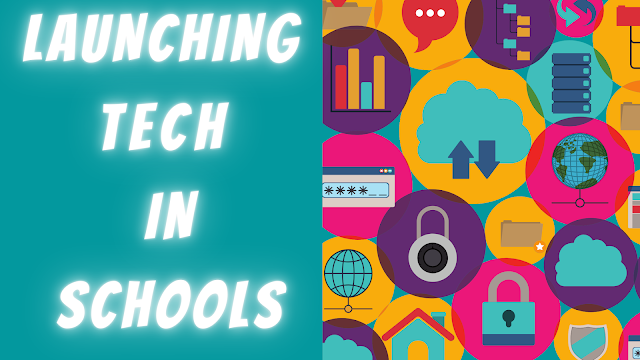How can we successfully launch new technology in schools?
The idea: Successfully launching new technology in schools involves four key steps: ‘Setting up Systems’ where leaders ensure the vision, culture and systemic supports for the innovation are in place; ‘Getting the ball rolling’ where high quality training on the tech is provided to introduce the team to it; ‘Greasing the wheels’ where the actions and impact of the early adopters are amplified; ‘Letting it roll’ where you consolidate and enable continuous improvement by supporting learning communities.
As the horror of the pandemic took over our lives last year, I witnessed a miracle unfold in our schools. Our teachers, students and parents embraced the opportunity before them, leapfrogged over many barriers (inexperience, access, etc.) and emerged a digitally competent community. Before the pandemic hit, I had dreamed this would happen in 3 years. It took 6 months. This had a lot to do with the pandemic, but also a little to do with how we approached the challenge, I believe.
How do you launch new technology and related innovations into schools? How do you ensure it is adopted by the team? Are some ways more effective than others? I think so. Here are some things I have learned through my own successes and failures in this area.
First, What does not work...
Mandating adoption and authoritarian approaches. You don’t get an inspired, empowered team by stripping them off their innate curiosity and desire to be creative. If people are told they ‘have to use it’, most react with an involuntary gag reflex that immediately makes the idea less exciting. It kills any agency they may have had, and also the chance for self-perpetuating growth.
Why am I mentioning this first? Because I have seen far too many leaders and schools adopt this approach before!
What works then?
1. Set up Systems
No successful, enduring tech transformation can happen without creating the systemic/ organizational conditions for the shift. Leaders play a pivotal role here and must:
- Inspire Change by communicating the vision and rationale behind the tech move. Leaders must also communicate the potential impact it can have for all stakeholders, most importantly the students.
- Build a Culture for innovation by ensuring the team (and of course the leader!) knows that the process involves learning together, hard work and of course, taking some risks and making a few mistakes. Central to this is trust, open-mindedness, collaboration and accountability.
- Provide Systems support for success. This includes ensuring that resources like people, time, tech hardware/software etc. are made available to relevant members.
2. Get the ball rolling
Don’t go all out constructivist with this phase and expect your team to discover this on their own! We know novices are empowered faster through explicit instruction. If you are in an organization where a very large portion of the team has no exposure to the new tech innovation, this step is critical. How this instruction is delivered is also critical. Do not treat this as box that needs to be checked off. You may also be tempted to hand this out to someone who is good with the tool but not so good at workshop/ instruction - don’t do that. The training should be high quality and valuable to your team - explicit, with lots of demonstrations and hands-on i.e. the team should have some guided practice. With this foundation, many will feel confident enough to try or take a chance with it.
3. Grease the wheels
The next step is to have your team dive in and grease the wheels of change. You can do this by seeking out the early adopters - the few teachers or team members who are the most eager and quickest to put the new technology into action. As a leader, your role is to find them and amplify their work in your organization. How? Make time to observe practices to find them. When you do, encourage them and find ways to share their work with other members in the organization. Highlight the impact very concretely if possible. You may even offer them opportunities to mentor a new team mate in this area or even start a task force that supports teachers who need help. If you are worried about not having any early adopters, I don’t believe you should be. I have found them in small teams of 20 people as well as in large ones of 200 people. You will find them, you just need to practice noticing. And encourage them whenever an opportunity presents itself.
4. Let it roll
Keep this up and soon you will get to a point where the majority of your team has adopted the technology. Now, it’s time to consolidate and sustain your learning by setting up learning communities - time and space for teachers to reflect on their implementation, share ideas and extend their knowledge collaboratively. Be patient. This is the best part. Why? It is the time when the excitement that comes with creative pursuit becomes visible in your team. The fulfillment that comes with mastery. And my favourite, self-perpetuated learning. When empowered and diverse team members apply the tech in novel ways in their own contexts, you notice the inertia from the early launch stage dissipate and the tech takes flight. It is magical!
At every stage in the process, authenticity is critical. An empowered team is built on a foundation of trust, with honest communication and sincere support throughout the process.
If you are interested in learning more about launching innovations in school, I highly recommend this fantastic Course from MITx - Launching Innovation in Schools, facilitated by one of my biggest inspirations on Leadership - Dr. Peter Senge along with Dr. Jason Reich.
Please note: When complex ideas are simplified into basic models to aid thinking, we lose some nuance. It is important to remember this limitation :)





Comments
Post a Comment